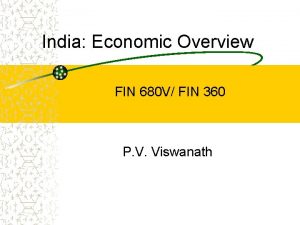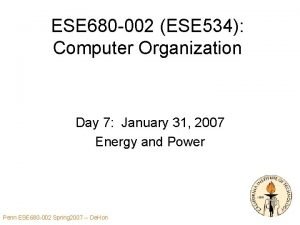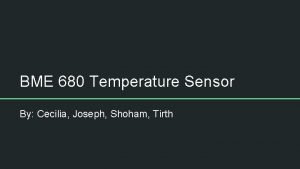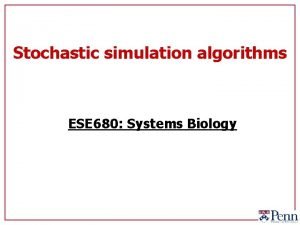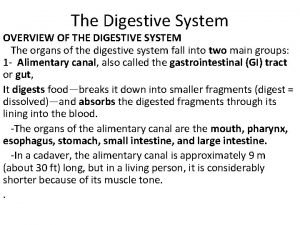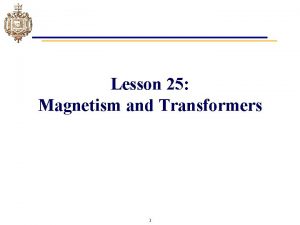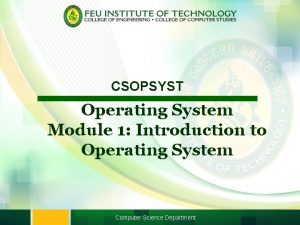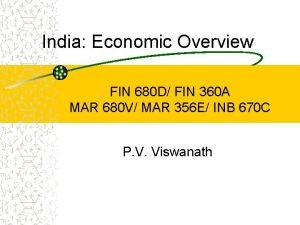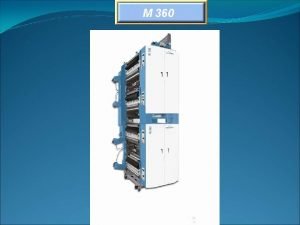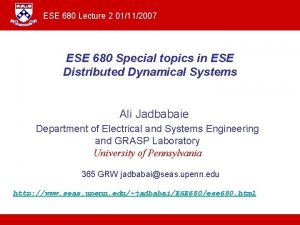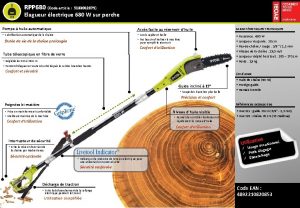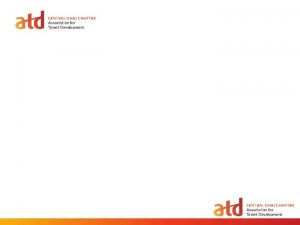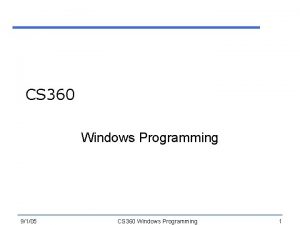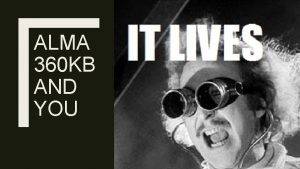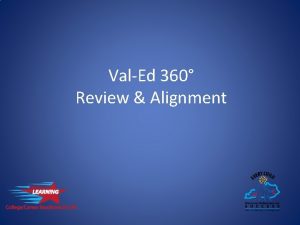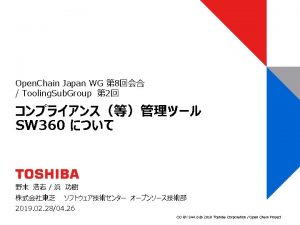India Economic Overview FIN 680 V FIN 360

































- Slides: 33

India: Economic Overview FIN 680 V/ FIN 360 P. V. Viswanath

Economic History: 1950 -1990 Post-independence India had a mixed economy, i. e. including both private and public sectors. The reasons for a strong public sector were: – Greate inequality in income distribution – doubts as to the viability of free markets – Free trade would probably have led to exploitation by stronger foreign countries • Exports were seen as a drain of resources from the country.

Post-independence economy Foreign Investment was seen as foreign domination. The quickest path to economic development was seen to be rapid industrialization, which would probably not happen without government intervention – Capital goods and heavy industry were seen as particularly needed. – Planning was needed to ensure industrial growth and the concomitant agricultural and service growth, as well as employment growth

Objectives The broad objectives were: – Rapid growth in production with a view to achieving a higher level of national and per -capita income. – Full employment – Reduction of inequalities in income and wealth – Socialistic pattern of society with a democratic framework, based on equality and justice and absence of exploitation.

Policy Measures for Industrial Development Trade and Regulatory Regimes designed to shield industrial producers from competition – High tariffs – Industrial licensing of production and investment – Monopoly and Restrictive Trade Practices (MRTP) Act – Foreign Exchange Regulation Act (FERA) – Export Restrictions

Industrial Policy Directed allocation of subsidized credit through the commercial and developmental banking system Administered interest rates and financial institutions required to lend for specific purposes at the administered rates. Fixed, overvalued exchange rates; this ensured cheap imports for the government.

Industrial & Agricultural Policy Price control for many products Rigid labor laws that made it difficult to lay off workers. Direct public investment in industrial activities. Management of the agricultural sector to ensure reasonable supplies of food grains, edible oils, sugar and cotton to the domestic market.

Agricultural Policy Procurement prices were fixed, which , in times of surplus, worked as a minimum support price. At times of deficit, the government mandatorily procured a part of the grain at the procurement price and distributed it to poorer people through ration shops. Fertilizer, irrigation, power and credit were subsidised for the agricultural sector.

Agricultural and Fiscal Policy The need to mop up excess production led to trade restrictions. – Quantitative restrictions on exports and imports, through licensing – Canalization – the use of a single parastatal for imports and exports; the use of minimum export prices. – High income tax rates

Social Policies Higher education was emphasized (IITs and IIMs) Growth-oriented strategy as a means of mitigating poverty and unemployment. However, structural inequalities in land ownership, availability of water, access to credit etc. led to growth without income and employment growth for poorer people.

Social Policies Land reform; however, it required the cooperation of the states, which was not always forthcoming for political reasons. Alleviation of poverty through special programs and policies, such as asset creation programs, employment generation programs, minimum needs programs. Intervention programs to solve the problems of malnutrition and hunger.

Did the policies work? Industry grew 6% p. a. between 1951 and 1989 There was little competition; hence there was little R&D. The capital-input ratio went up considerably; total factor productivity dropped. Capacity utilization fell. Deeply entrenched interest groups.

Agricultural Progress Between 1950 and 1980, food grain production increased by 2. 8% p. a. , due primarily to productivity gains and multiple cropping. But, investment growth slowed. R&D suffered, development of irrigation lagged behind plan targets. There was a substantial rise in subsidies for food and fertilizer and for credit, water and electricity. India became more or less self-reliant, but at

Social Progress From 1970 -88, the proportion of population below poverty dropped from 46. 17% to 37. 76% in urban areas and from 58. 75% to 48. 69% in rural areas. Average life expectancy improved from 32. 1 in 1950 -51 to 58. 7 in 1990 -91. The death rate dropped from 27. 4 to 12. 5 during the same period. Literacy was 52. 2% in 1990 -91 compared to 18. 33% in 1950 -51. But compared to other developing countries, this was not good.

The crisis and the change A massive rise in the government deficit spilled over to the current account deficit because it was financed by external debt. External shocks, such as increased oil prices, decreased access to concessionary loans from abroad Structural rigidities in the Indian economy made Indian products non-

The solution A twofold solution: – Make the economic structure more competitive – Contain the government deficit Effects: – Structural Change and – Fiscal stabilization.

Initial Reforms Trade policy reforms have done away with most quantitative restrictions and reduced tariff levels Industrial policy has removed barriers to entry and limits on growth in the size of firms Regimes foreign investment and foreign technology have been liberalized considerably Domestic tax structure has been

Second-generation reforms Privatization of public sector undertakings – Very slow, but steady. BHEL Exit policy for labor Reforms of the agricultural sector Reforms of the state government

0 2008 -09 2006 -07 2004 -05 2002 -03 2000 -01 1998 -99 1996 -97 1994 -95 1992 -93 1990 -91 1988 -89 1986 -87 1984 -85 1982 -83 1980 -81 1978 -79 1976 -77 1974 -75 1972 -73 1970 -71 1968 -69 1966 -67 1964 -65 1962 -63 1960 -61 1958 -59 1956 -57 1954 -55 1952 -53 1950 -51 GDP from 50 -51 to 2008 -9 GDP at Factor Cost 6000000 5000000 4000000 3000000 2000000 1000000

91 19 -92 92 19 -93 93 19 -94 94 19 -95 95 19 -96 96 19 -97 97 19 -98 98 19 -99 99 20 -00 00 20 -01 01 20 -02 02 20 -03 03 20 -04 04 20 -05 05 20 -06 06 20 -07 07 20 -08 08 -0 9 19 GDP: Post Liberalization GDP at Factor Prices 6000000 5000000 4000000 3000000 Series 1 2000000 1000000 0

Industrial Production Index Nos of Industrial Production (1993: 94 Base) 350. 00 300. 00 250. 00 200. 00 150. 00 100. 00 50. 00 W ei 19 ght 94 19 -95 95 19 -96 96 19 -97 97 19 -98 98 19 -99 99 20 -00 00 20 -01 01 20 -02 02 20 -03 03 20 -04 04 20 -05 05 20 -06 06 20 -07 07 20 -08 08 20 -09 09 -1 0 0. 00 Mining & Quarrying Manufacturing Electricity General

Growth in Industrial Production Atul Kohli, “Politics of Economic Growth in India, 1980 -2005, ” Economic and Political Weekly, April 2006, pp. 1251 -1259 and 1361 -1370

Changes post-1991 Disparity in growth across states Move towards service sector Lack of industrial growth Income inequalities High poverty in the rural sector – farmer suicides Continued casteism, gender inequality, communal unrest

Economic Discrimination Two theories of employee discrimination: – Statistical Discrimination – desired characteristics are more prevalent in the sought-after group. Hence employees belonging to this group are preferred. – A recent study concluded that SC/ST graduates of the 2006 IIM-Ahmedabad batch got jobs with lower pay offers. – The study found that after adjusting for

Economic Discrimination Preference-Based Discrimination (Becker) If employers prefer to associate with employees of a certain background, then that characteristic will be priced – employees of the favored group will be preferred even if there is no difference on efficiency grounds. This may be changed by advertising,

Benefits of Capital Account Convertibility to stimulate economic growth through higher investment by minimizing the cost of both equity and debt capital; to improve the efficiency of the financial sector through greater competition, thereby minimizing intermediation costs and to provide opportunities for diversification of investments by

Capital Account Convertibility CAC based on theory that capital will flow from high capital-endowment countries to low capital-endowment countries, from low-returnto-capital countries to high-return-to-capital countries. But CAC often led to movement of capital from developing countries to developed countries. One reason is information asymmetry problems in developing countries combined with contract enforcement difficulties.

Capital Account Convertibility Currently in India, the rupee is fully convertible for current account transactions. Capital account transactions are transactions that alter the assets or liabilities outside India of an Indian or inside India of a non-Indian, i. e. that convert local financial assets into foreign financial assets – for such

Capital Account Convertibility State governments are not allowed to directly access any form of external borrowing Banks are not allowed to borrow abroad; however, Indian companies are allowed ECBs (external company borrowings). Foreigners are allowed to invest in India only in certain sectors and subject to

Capital Account Convertibility: Examples In insurance, they are not allowed to operate directly, but they can have a joint venture with up to a 26% equity interest. Foreign investment is not permitted in the retail sector with certain restrictions. – 100% FDI is permitted for wholesale cash and carry trading and trading for exports – 51% FDI permitted for Single Brand product retailing

BSE Sensex Prices BSE Sensex Index 70000 60000 50000 40000 Volume 30000 Close 20000 10000 9 3/ 2 00 8 7/ 7/ 3/ 2 00 7 3/ 2 00 6 7/ 7/ 3/ 2 00 5 3/ 2 00 4 7/ 7/ 3/ 2 00 3 3/ 2 00 2 7/ 7/ 3/ 2 00 1 00 3/ 2 7/ 7/ 3/ 2 00 0 0

BSE Sensex Prices 25000 20000 15000 Volume/10 10000 Close 5000 9 9/ 2/ 2 00 9 2/ 2 8/ 00 2/ 2 7/ 00 9 9 6/ 2/ 2 00 9 5/ 2/ 2 00 9 00 2/ 2 4/ 3/ 2/ 2 00 9 09 20 2/ 2/ 1/ 2/ 2 00 9 0

Stock Market Efficiency Stock prices are trending up. There is tremendous volume However, in order for the stock market to work as an efficient mechanism for channeling resources, prices have to reflect true value. One requirement for this to happen is that the market should not be manipulable by a few parties.
 Fin 360
Fin 360 Fin 360
Fin 360 Spf fin fod fin
Spf fin fod fin Prisme droit à base trapèze
Prisme droit à base trapèze A 680 newton student runs up a flight of stairs
A 680 newton student runs up a flight of stairs F tag 842
F tag 842 Christina corrigan
Christina corrigan Ese 680
Ese 680 Bme 680
Bme 680 The expanded form of ms word is
The expanded form of ms word is Altair 680b
Altair 680b Ese 680
Ese 680 Ese 680
Ese 680 Talk 680
Talk 680 Nur 680
Nur 680 Economic growth vs economic development
Economic growth vs economic development Prof. meier and baldwin
Prof. meier and baldwin Lesson 2 our economic choices
Lesson 2 our economic choices Definition of software testing
Definition of software testing Why consulting
Why consulting Pseudo wire
Pseudo wire Iptv technology overview
Iptv technology overview C language overview
C language overview Multinational financial management an overview
Multinational financial management an overview Overview of the digestive system
Overview of the digestive system Uml overview
Uml overview Lesson overview
Lesson overview American literature overview
American literature overview Transformer overview
Transformer overview H&m company overview
H&m company overview Dual mode in os
Dual mode in os Nature of hrm
Nature of hrm Dell emc services
Dell emc services What is classification of matter
What is classification of matter
